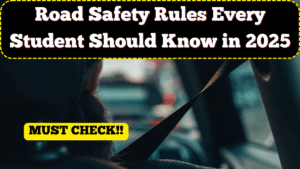In today’s fast-paced world, ensuring the safety of school-going children has become more critical than ever. With increasing traffic, distracted driving, and urban congestion, understanding and following traffic rules for kids is no longer optional—it’s a life-saving necessity. The year 2025 brings updated safety protocols and school commuting guidelines that every parent, teacher, and student must be aware of.
Road safety is not just about drivers being careful—it’s about teaching children the skills and habits that protect them while walking, cycling, or commuting by bus or car. Educating students on these rules from an early age builds lifelong awareness, responsibility, and confidence when navigating roads independently.

Why Road Safety for Students Is a Priority in 2025
India has seen a significant rise in road accidents involving children, especially in school zones. Poor pedestrian behavior, lack of crosswalk discipline, and reckless two-wheeler riding by students are some common causes. Here’s why traffic rules for kids are being emphasized more in 2025:
-
Government has mandated road safety sessions in schools
-
RTOs are collaborating with schools for student awareness drives
-
More focus on safe zones, speed bumps, and CCTV in school areas
-
Schools are now accountable for ensuring children are taught about road behavior
Creating a generation of alert and safety-conscious children starts with the right information and daily practice.
Essential Traffic Rules Every Student Must Follow
Whether walking to school, cycling, or using a school van, here are the top student tips for staying safe on the road:
-
Use Zebra Crossings: Always cross at marked pedestrian lines. Wait for the green signal if present.
-
Look Both Ways: Even on one-way streets, look both left and right before crossing.
-
Avoid Running on Roads: Walk calmly and stay focused; sudden movement can confuse drivers.
-
Use Sidewalks: Stick to footpaths. If unavailable, walk on the right side facing oncoming traffic.
-
Wear Helmets When Cycling: A helmet can reduce head injuries by up to 70%.
-
Don’t Use Phones or Headphones: Stay alert—avoid music, games, or texting near traffic.
-
Board Vehicles Safely: Get on/off the school bus only when it stops completely, and stand in a line.
By turning these habits into routines, school awareness increases across communities and neighborhoods.
Role of Schools and Parents in Student Road Safety
The responsibility of enforcing road safety does not lie with students alone. Schools and parents play a pivotal role in modeling and reinforcing the right behavior:
-
Schools Should:
-
Conduct weekly road safety assemblies
-
Invite RTO officials for safety demonstrations
-
Paint school zone signage, install speed breakers, and use volunteers at gates
-
-
Parents Must:
-
Never ride bikes with children without helmets
-
Avoid parking in ‘No Parking’ zones near schools
-
Teach children about traffic signals and safe road behavior during daily commutes
-
Creating a student tips checklist for your child can also help reinforce these lessons consistently.
Road Safety Accessories and Gear for Children
Children should be equipped with practical safety items when commuting:
| Item | Purpose | Tip for Parents and Schools |
|---|---|---|
| Reflective School Bags | Increases visibility during early mornings | Choose bright-colored bags with strips |
| Bicycle Helmets | Reduces head injury during falls | Ensure ISI-certified and size-fitted |
| Safety Vests (for walkers) | Keeps kids visible during evening hours | Use for kids who walk in low-light |
| ID Cards with Emergency Info | Helps in identification during emergencies | Include school, parent numbers |
| Road Safety Badges or Bands | Reminds students about rules in a fun way | Schools can distribute during events |
Equipping kids with the right safety gear enhances their protection and visibility on busy roads.
FAQs
Why is road safety education important for students in 2025?
With increasing road traffic and urban hazards, teaching traffic rules for kids ensures children know how to safely walk, cross, and commute to school independently.
What are the top three traffic rules every child must follow?
Always use zebra crossings, never run across roads, and avoid distractions like phones or headphones near traffic.
Should students wear helmets on bicycles?
Yes, wearing helmets is now a part of student tips taught in schools and is vital for safety when riding cycles.
What can schools do to promote road safety?
Schools can host road safety weeks, paint crosswalks, and organize sessions with local traffic police to teach children the basics of road safety.
How can parents contribute to road safety awareness?
By setting a good example, talking to children regularly about safety, using helmets, and avoiding illegal parking near schools, parents reinforce everyday awareness.
Click here to know more.
